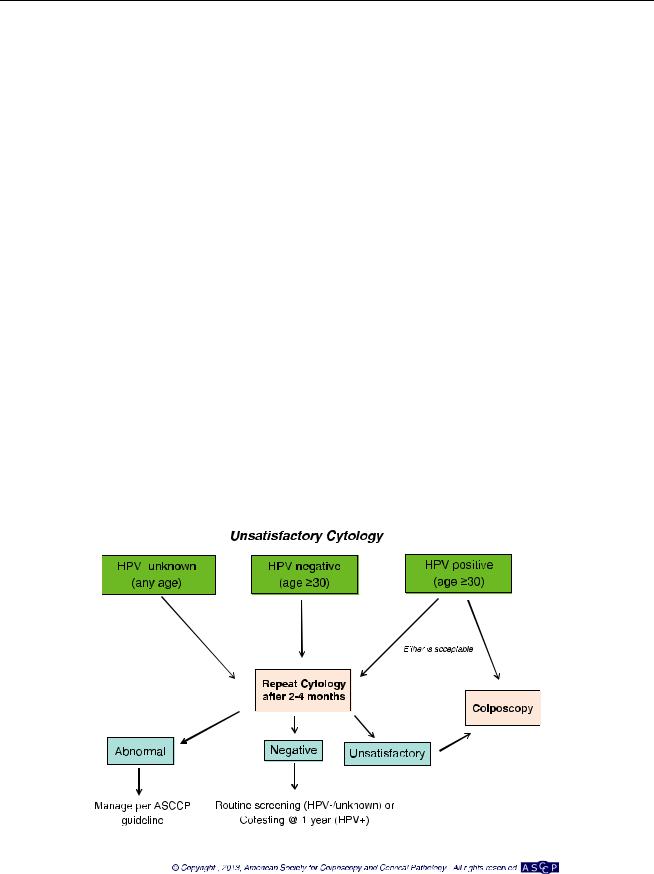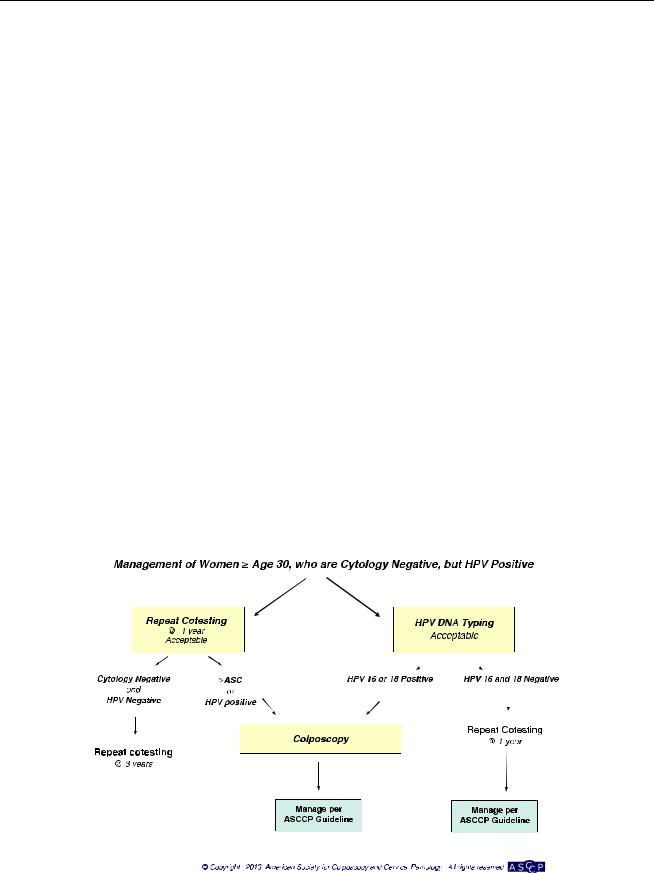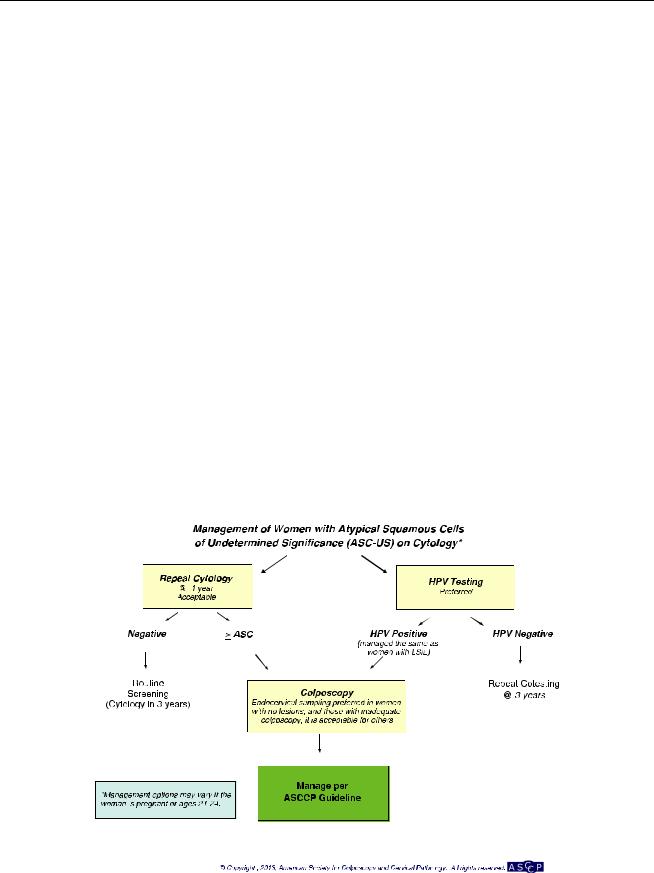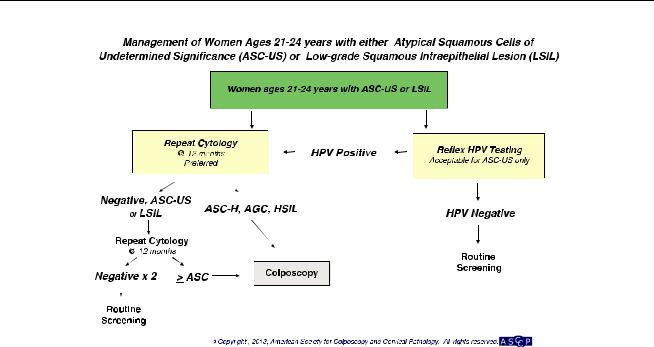
2012 asccp updated guidelines for the management of abnormal cervical cancer screening tests and cancer precursors
.Pdf
2012 Updated Consensus Guidelines for the Management of Abnormal Cervical Cancer Screening Tests and Cancer Precursors
L. Stewart Massad, MD, Mark H. Einstein, MD, Warner K. Huh, MD, Hormuzd A. Katki, PhD, Walter K. Kinney, MD, Mark Schiffman, MD, Diane Solomon, MD, Nicolas Wentzensen, MD, and Herschel W. Lawson, MD, for the 2012 ASCCP Consensus Guidelines Conference
From Washington University School of Medicine, St. Louis, Missouri; Albert Einstein College of Medicine, New York, New York; University of Alabama School of Medicine, Birmingham, Alabama; Division of Cancer Epidemiology and Genetics and Division of Cancer Prevention, National Cancer Institute, Bethesda, Maryland; The Permanente Medical Group, Sacramento, California; and Emory University School of Medicine, Atlanta, Georgia
h ABSTRACT: A group of 47 experts representing 23 professional societies, national and international health organizations, and federal agencies met in Bethesda, MD, September 14Y15, 2012, to revise the 2006 American Society for Colposcopy and Cervical Pathology Consensus Guidelines. The group’s goal was to provide revised evidence-based consensus guidelines for managing women with abnormal cervical cancer screening tests, cervical intraepithelial neoplasia (CIN) and adenocarcinoma in situ (AIS) following adoption of cervical cancer screening guidelines incorporating longer screening intervals and co-testing. In addition to literature review, data from almost 1.4 million women in the
These guidelines are being published simultaneously in Obstetrics & Gynecology and the Journal of Lower Genital Tract Disease. The complete algorithms are published in the Journal of Lower Genital Tract Disease and are also available on the web site of the American Society for Colposcopy and Cervical Pathology (http://www.asccp.org/).
The contents of this article are solely the responsibility of the authors and do not necessarily represent the official views of the National Institutes of Health or U.S. federal government.Corresponding author: L. Stewart Massad, MD Division of Gynecologic Oncology, Washington University School of Medicine, 4911 Barnes-Jewish Hospital Plaza, St. Louis, MO 63110; e-mail: massadl@wudosis.wustl.edu.
Financial Disclosure
Dr. Massad has served as an expert witness. Dr. Huh has served as a consultant to Roche. Dr. Schiffman has researched reagents for Qiagen and Roche. The other authors did not report any potential conflicts of interest.
! 2013, American Society for Colposcopy and Cervical Pathology
Journal of Lower Genital Tract Disease, Volume 17, Number 5, 2013, S1YS27
Kaiser Permanente Northern California Medical Care Plan provided evidence on risk after abnormal tests. Where data were available, guidelines prescribed similar management for women with similar risks for CIN 3, AIS, and cancer. Most prior guidelines were reaffirmed. Examples of updates include: Human papillomavirusYnegative atypical squamous cells of undetermined significance results are followed with co-testing at 3 years before return to routine screening and are not sufficient for exiting women from screening at age 65 years; women aged 21Y24 years need less invasive management, especially for minor abnormalities; postcolposcopy management strategies incorporate co-testing; endocervical sampling reported as CIN 1 should be managed as CIN 1; unsatisfactory cytology should be repeated in most circumstances, even when HPV results from co-testing are known, while most cases of negative cytology with absent or insufficient endocervical cells or transformation zone component can be managed without intensive follow-up. h
By 2001, revised Bethesda system terminology for reporting cervical cytology results and the availability of findings from a recent randomized trial of strategies
for managing minor cervical cytologic abnormalities had created the need for a standard approach to managing women with abnormal cervical cytology and cervical cancer precursors (1Y3). In response, the American Society for Colposcopy and Cervical Pathology (ASCCP) initiated

S2 & M A S S A D E T A L .
a process that developed comprehensive, evidence-based consensus guidelines to aid clinicians in managing women with abnormal cervical cytology, cervical intraepithelial neoplasia (CIN), and adenocarcinoma in situ (AIS) (4, 5). Although those guidelines became the standard for managing women with abnormal cervical cytology and cancer precursors, the need for revisions became apparent. A second consensus conference in 2006 aligned management of minor cytologic abnormalities and CIN 1, incorporated follow-up results of the ASCUS-LSIL Triage Study (ALTS), identified strategies for management of positive human papillomavirus (HPV) DNA tests, and established guidelines for management of adolescents and young women (6, 7).
As updated in 2001, the Bethesda System also defined terminology for cytologic specimen adequacy, and ASCCP developed management guidelines for women with unsatisfactory cytology results and for those with negative results but limited endocervical/transformation zone (EC/TZ) component (8). These guidelines were updated in 2008 (9) but were not validated by a national consensus conference.
Previous guidelines remain valid, but knowledge has advanced. Screening has changed. In 2012, national organizations published guidelines embracing longer screening intervals and a later age to start screening (10, 11). Co-testing with cytology and HPV testing at 5-year intervals is now the preferred or acceptable strategy for cervical cancer screening for women aged 30Y64 years (10, 11). Clinicians should benefit from guidance on how to incorporate co-testing into management of women with cervical abnormalities.
In addition, new evidence to guide decisions about management of abnormal screening tests and CIN and AIS emerged in 2012 from analyses of the large clinical database at the Kaiser Permanente Northern California Medical Care Plan (KPNC), conducted in collaboration with scientists from the National Cancer Institute (NCI) (12). This new evidence fills gaps in the 2006 guidelines. For example, prior management guidelines relied heavily on data from ALTS, which provided evidence on initial management of women with minor cytologic abnormalities. Results were extrapolated to provide guidelines on management of women with more severe cytologic abnormalities and post-colposcopy follow-up. The newer evidence from KPNC analyses allows validation or modification of prior guidelines in specific areas. The size of the KPNC database also allows age-based stratification of data for some types of abnormalities. While these observational data from a single U.S. region may limit generalizability and the lack of follow-up
beyond 8 years may limit long-term risk estimates, publication of comparable analyses from similarly large databases soon is unlikely.
Finally, additional data have emerged in specific areas. Human papillomavirus genotyping tests have been approved; these have been recommended as an option for specific clinical scenarios to guide triage to colposcopy. More information is also available to guide management of women with unsatisfactory cytology.
In response, ASCCP conducted a consensus process to update the management of abnormal co-testing results and cytology with specimen adequacy limitations, the initial management of abnormal screening test results, options for postcolposcopy management, management of women aged 21Y24 years, and other issues. This report details the consensus guidelines developed through this process.
METHODS
The process for the 2012 consensus guidelines was similar to that for the previous guidelines (4Y7). Initially the ASCCP Practice Committee defined questions for the 2012 consensus process. A steering committee of nationally recognized experts in cervical cancer prevention was nominated and canvassed for additional questions. At the March 2012 ASCCP Biennial Scientific Meeting, conference attendees presented suggestions for guidelines review. Organizations that participated in the 2006 guidelines development process were solicited to nominate representatives to the revision process and also were asked to identify questions for review. Participants and participating organizations are listed in Appendix A.
A multifaceted process was used to evaluate the evidence and resolve identified issues. Five working groups were created, chaired by steering committee members and including delegates from participating organizations. For some working groups, the MEDLINE database was queried using relevant key words for English-language articles published after 2005, the date of the last consensus conference review (see Appendix 1, available online at http://links.lww.com/LGT/A9). Potentially relevant abstracts from identified articles were reviewed. Reports were rated according to the strength and quality of relevant evidence.
Other working groups focused on analyses of outcomes risk from a database of 1.4 million women cared for at KPNC and followed from January 1, 2003 to December 31, 2010. The primary outcome of interest in these analyses was CIN 3+ (CIN 3, AIS, and cancer). Cancer was used as an outcome when risk was high and CIN 2+ (CIN 3+ and

ASCCP Guidelines Update & S3
CIN 2) was used when the number of CIN 3+ events was low. Applying the concepts of ‘‘similar management for similar risks,’’ risks were benchmarked to those for accepted management strategies. Since delegates considered zero cancer risk unattainable and CIN 3+ a reasonable proxy for cancer risk, acceptable risks were considered to be those approximating CIN 3+ risk 3 years after negative cytology or 5 years after negative co-testing. In brief, immediate colposcopy was recommended when the 5-year risk of CIN 3+ in the KPNC cohort exceeded 5%, a 6-month to 12-month return for risk of 2Y5%, a 3-year return for risk of 0.1Y2%, and a 5-year return interval for risk comparable to co-testing in women without a history of abnormality, or 0.1%. (12).
Draft guidelines developed by the working groups were posted to the ASCCP web site, and comments were solicited from collaborating organizations and the public. Draft guidelines revised in light of public comments were presented to a consensus conference convened September 14Y15, 2012, at the Natcher Conference Center on the campus of the National Institutes of Health in Bethesda, MD. Draft guidelines and supporting evidence were presented, discussed, revised as needed, and adopted by at least 66% of voting delegates using electronic voting devices.
The terminology used in the updated guidelines is similar to prior versions, and the two-part rating system is the same (Table 1). Ratings are given in parentheses throughout the guidelines. The terms recommended, preferred, acceptable, and unacceptable are used in the guidelines to describe various interventions. A new term, ‘‘not recommended,’’ was added to describe management strategies with weak evidence against their use but only marginal risk for adverse consequences. The strength rating of a recommendation was based on the quality of evidence supporting it but incorporated other factors, including potential for harm if an intervention did not occur and potential complications from a given intervention.
For cytologic classification and assessment of cytology specimen adequacy, the 2001 Bethesda System was used
(1). For histologic classification, a two-tiered system was employed. Low-grade lesions were termed CIN 1 and highgrade lesions were termed CIN 2 or CIN 3. Some pathologists do not distinguish CIN 2 from CIN 3, and these undifferentiated high-grade lesions are termed CIN 2,3.
GUIDING PRINCIPLES
Participants at the consensus conference affirmed that the 2006 ASCCP guidelines for the management of abnormal cervical cancer screening tests (6) and CIN
Table 1. Rating the Recommendations
Strength of recommendation*
Good evidence for efficacy and substantial
clinical benefit support recommendation for use. Moderate evidence for efficacy or only limited
clinical benefit supports recommendation for use. Evidence for efficacy is insufficient to support a
recommendation for or against use, but recommendations may
be made on other grounds.
Moderate evidence for lack of efficacy or for adverse outcome supports a recommendation against use.
Good evidence for lack of efficacy or for adverse outcome supports a recommendation against use.
Evidence from at least one randomized,
|
controlled trial. |
II |
Evidence from at least one clinical trial without |
|
randomization, from cohort or case-controlled |
|
analytic studies (preferably from more than |
|
one center), or from multiple time-series studies, |
|
or dramatic results from uncontrolled experiments. |
III |
Evidence from opinions of respected authorities |
|
based on clinical experience, descriptive studies, |
|
or reports of expert committees. |
Terminology used for recommendations† |
|
Recommended |
Good data to support use when only one |
|
option is available. |
Preferred |
Option is the best (or one of the best) when |
|
there are multiple options. |
Acceptable |
One of multiple options when there is either |
|
data indicating that another approach is |
|
superior or when there are no data to |
|
favor any single option. |
Not recommended |
Weak evidence against use and marginal risk |
|
for adverse consequences. |
Unacceptable |
Good evidence against use. |
* Modified from Gross PA, Barrett TL, Dellinger EP, et al. Purpose of quality standards for infectious diseases. Infectious Diseases Society of America. Clin Infect Dis 1994;18:421. 98. Kish MA. Guide to development of practice guidelines. Clin Infect Dis 2001;32:851Y4.
† The assignment of these terms represents an opinion ratified by vote during the 2012 consensus conference.
or AIS (7) remain valid, with the exception of the specific areas reviewed. Those earlier guidelines have been combined with current revisions in this document to provide comprehensive recommendations for management. Changes are summarized in Box 1.
Cervical cancer prevention is a process with benefits and harms. Risk cannot be reduced to zero with currently available strategies, and attempts to achieve zero risk may result in unbalanced harms, including overtreatment. As noted in a 2011 consensus conference on cervical cancer screening (10), optimal prevention strategies should identify those HPV-related abnormalities likely to progress to invasive cancers while avoiding destructive treatment of abnormalities not destined to become cancerous. Adopted management strategies provide what participants considered an acceptable level of risk of failing to detect high-grade neoplasia or cancer in a given clinical situation. Where data were available,

S4 & M A S S A D E T A L .
Box 1. Essential Changes From Prior Management
Guidelines*
&Cytology reported as negative but lacking endocervical cells can be managed without early repeat.
&CIN 1 on endocervical curettage should be managed as CIN 1, not as a positive ECC.
&Cytology reported as unsatisfactory requires repeat even if HPV negative.
&Genotyping triages HPV-positive women with HPV type 16 or type
18 to earlier colposcopy only after negative cytology; colposcopy is indicated for all women with HPV and ASC-US, regardless of genotyping result.
&For ASC-US cytology, immediate colposcopy is not an option. The serial cytology option for ASC-US incorporates cytology at 12 months, not
6 months and 12 months, and then if negative, cytology every 3 years.
&HPV-negative and ASC-US results should be followed with co-testing at 3 years rather than 5 years.
&HPV-negative and ASC-US results are insufficient to allow exit from screening at age 65 years.
&The pathway to long-term follow-up of treated and untreated CIN 2+
is more clearly defined by incorporating co-testing.
&More strategies incorporate co-testing to reduce follow-up visits. Pap-only strategies are now limited to women younger than 30 years, but co-testing is expanded even to women younger than 30 years in some circumstances. Women aged 21-24 years are managed conservatively.
CIN, cervical intraepithelial neoplasia; ECC, endocervical curettage; HPV, human papillomavirus; ASC-US, atypical squamous cells of undetermined significance.
*Prior management guidelines were from the ‘‘2006 Consensus Guidelines for the Management of Women With Abnormal Cervical Screening Tests’’ (6). Prior guidelines not changed were retained.
similar management strategies were prescribed for similar levels of risk (12, 13). Guidelines cannot be developed for all situations. Clinical judgment should always be applied when applying guidelines to individual patients. This is especially true for guidelines based on less robust evidence.
In 2012, the Lower Anogenital Squamous Terminology (LAST) Project created new terminology for HPVrelated lesions of the lower genital tract (14). However, delegates to the current consensus process determined that this classification does not yet have a sufficiently robust outcomes evidence base to allow elucidation of risk-based management guidelines (see Box 2).
Algorithms detailing the different management recommendations are available at the ASCCP web site (www.asccp.org/consensus2012). A glossary of terms used in the guidelines is in Appendix B.
In the 2006 ASCCP guidelines,(6,7) several pathways concluded by returning women to ‘‘routine screening.’’ This term was not defined, but in 2006, screening guidelines prescribed cytology at shorter intervals than now recommended. Current 2011 screening guidelines recommend either 3-year cytology intervals or, for women aged 30Y64 years, 5-year co-testing intervals (10, 11). These multi-year intervals are safe only when risk for the development of CIN 3+ during the years between testing is low (10, 11). For example, women aged 30Y64 years with a negative co-test have a 5-year
risk of CIN 3+ of only 8/10,000 (12). Although this low level of risk can be achieved among women with negative screening histories, for those with some abnormalities, risk for CIN 3+ remains elevated for years, even after treatment and even after initial negative surveillance. After some abnormalities, current follow-up data are insufficient to define a pathway to return to 5-year routine screening intervals because even with treatment, risk does not fall to a level consistent with 5-year retesting.
When, how, and even whether to perform endocervical sampling is controversial. Endocervical brushing has better sensitivity than curettage with similar specificity, better tolerance, and fewer insufficient samples, although grading may be more difficult because stroma is rarely sampled with brushing (15, 16). Either is acceptable for endocervical sampling. In 2006, working groups assessing management of cytology reported as atypical squamous cells of undetermined significance (ASC-US) and low-grade squamous intraepithelial lesions (LSIL) defined indications for endocervical sampling, guidance that should be valid for women with cytology results of atypical squamous cells, cannot exclude high-grade squamous intraepithelial lesions (ASC-H) and high-grade squamous intraepithelial lesions (HSIL) as well.
Management strategies incorporate HPV testing based on studies using validated HPV assays. Management based on results of HPV tests not similarly validated may not result in intended outcomes and may risk patient harm. These guidelines are intended for use only with HPV tests that have been analytically and clinically validated with proven acceptable reproducibility, clinical sensitivity, specificity, and positive and negative predictive values for cervical cancer and verified precancer (CIN 2+), as documented by U.S. Food and Drug Administration (FDA) licensing and approval or publication in peerreviewed scientific literature. Testing should be restricted to high-risk (oncogenic) HPV types (mainly 16, 18, 31, 33, 35, 39, 45, 51, 52, 56, 58, and 59), and in these guidelines ‘‘HPV testing’’ refers only to testing for high-risk
Box 2.
A recent consensus conference (the Lower Anogenital Squamous Terminology [LAST] Project convened by the College of American Pathologists and the American Society for Colposcopy and Cervical Pathology) adopted a two-tier terminology that incorporates ancillary tests and other criteria to distinguish indeterminate lesions as high grade or low grade. Until a comprehensive evidence review and consensus guidelines development process can be conducted, histopathology results reported as low-grade squamous intraepithelial lesions (LSIL) should be managed as cervical intraepithelial neoplasia (CIN) 1 and those reported as high-grade squamous intraepithelial lesions
(HSIL) should be managed as CIN 2,3 (14).

ASCCP Guidelines Update & S5
(oncogenic) HPV types. Testing for low-risk (nononcogenic) HPV types has no role in the evaluation of women with abnormal cervical cytologic results.
Both ablation and excision effectively treat CIN. Randomized trials comparing different modalities show similar efficacy (17Y20). Efficacy rates range from 90% to 95%, and most failures occur within 2 years (21), although cancers can develop up to 20 years after treatment (22). Margin status is a convenient predictor of recurrence and a traditional risk marker, although it does not appear to be an independent risk factor (23, 24). Nonsurgical therapies, including topical agents and therapeutic vaccines, remain investigational.
A wide variety of follow-up approaches have been described for women treated for CIN, incorporating cytology, HPV testing, and colposcopy alone or in combination at intervals from 3 months to annually. HPV testing is more sensitive but less specific than cytology in posttreatment follow-up and it may result in earlier diagnosis of persistent or recurrent disease (25). Protocols for follow-up after treatment of CIN have not been evaluated as primary interventions in randomized trials.
Under the 2011 screening guidelines, women followed after positive HPV tests but negative cytology were referred to colposcopy only if they had LSIL or more severe cytology or a positive HPV test during surveillance co-testing (10). However, only 0.04% of all women aged 30-64 years in the KPNC database had HPV-negative ASC-US after an HPV-positive, cytology negative result (26), so referring these women for colposcopy will burden care systems minimally. Thus, for simplicity, current guidelines recommend colposcopy for any positive HPV test or any abnormal cytology during follow-up.
Studies of the effect of treatment on future pregnancy are conflicting, although many indicate an approximately two-fold increase in preterm delivery risk (27Y29). Although not proven, this is presumed to result from deficient cervical stroma, and risk appears to increase with the volume and number of excisions (30). However, many studies were done in countries where loop excisions are performed with larger loop sizes and deeper excisions than most U.S. clinicians employ. Studies linking ablative treatments to preterm delivery are even more limited and conflicting. Women with CIN may be at increased risk for preterm delivery even when untreated. Nevertheless, because pregnancy complications can be devastating, the potential benefits of treatment should be balanced against the risk to
future pregnancies. Young women have high regression rates for cervical disease and low cancer risk (31Y33). The term ‘‘young women’’ indicates those who after counseling by their clinicians consider risk to future pregnancies from treating cervical abnormalities to outweigh risk for cancer during observation of those abnormalities. No specific age threshold is intended.
In 2006, guidelines recommended less aggressive management for adolescents with cervical abnormalities (6, 34), but these are now moot because the 2011 screening guidelines recommend not screening adolescents (10, 11). Delegates to the 2012 consensus conference considered less intensive management for other young women with abnormal cytology. Cervical cancer risk remains low through age 25 years (35), HPV is common (36), and lesions often regress (37). The annual incidence of cervical cancer among U.S. women aged 21Y24 years is 1.4/100,000, and almost 55,000 cytology tests must be obtained for every cervical cancer diagnosed in this age group (35). This level of risk is 10-fold higher than risk in adolescents and appears to be high enough to justify screening yet is low enough to allow observation for minor cytologic abnormalities. Guidelines for women aged 21Y24 years can be extrapolated to adolescents inadvertently screened.
Interventions for abnormal screening tests and CIN or AIS have other consequences that are not easily measurable. Women experience emotional distress when receiving abnormal cytology and HPV test results, when having colposcopy even when findings are normal, and when undergoing cervical treatment. Emotional distress is usually prompted by uncertainty and anticipation of the unknown (38). Many management strategies incorporate follow-up with HPV testing, which can elicit feelings of stigma and shame when positive despite the near-ubiquitous frequency of HPV infection (39, 40). The anxiety and time required for visits to manage abnormal cytology can adversely affect relationships, work-related and school activities, and family matters (41). These potential harms reinforce the concept that colposcopy and other interventions should be avoided when risk for CIN 3+ is low and when identified lesions are likely to resolve.
In the 2001 guidelines (4), separate recommendations for ASC-US management were developed for women infected with human immunodeficiency virus and other immunosuppressive conditions. Data review in 2006 eliminated these separate guidelines. Immunosuppressed women with abnormal results should be managed in the same manner as immunocompetent women.

S6 & M A S S A D E T A L .
Guidelines on management apply only to women undergoing routine screening with adequate visualization of the cervix and directed sampling with acceptable collection instruments. They also apply only to women identified with abnormalities during screening. Women with postcoital or unexplained abnormal vaginal bleeding, pelvic pain, abnormal discharge, or a visible lesion merit individualized evaluations.
Consensus guidelines from the ASCCP have international influence. However, they are tailored to the opportunistic cervical cancer screening system of the United States, with specific terminology, diagnostic criteria, pathways to colposcopic training, patient expectations and adherence, and medicalYlegal risks. Clinicians elsewhere must consider the guidelines in light of their own context and adapt management accordingly.
MANAGEMENT OF ABNORMAL SCREENING TESTS
Unsatisfactory Cytology
Cytology results are unsatisfactory for 1% or less across all preparation types (42, 43). Unsatisfactory cytology specimens are unreliable for detecting epithelial abnormalities. However, most studies that found a higher risk of disease among women with unsatisfactory cytology employed conventional Pap tests that can be rendered unsatisfactory by obscuring blood, inflammation, or
other processes (44, 45). Now that most U.S. cytology is done using liquid-based media, which can control for most obscuring factors in processing, unsatisfactory results arise largely from insufficient squamous cells (46). Evidence is sparse governing management of women with unsatisfactory cytology obtained as part of co-testing, although risk for high-grade disease in women with negative HPV tests appears to be low (47). Unsatisfactory results arise largely from insufficient squamous cells (48). Some currently available HPV tests lack a control for epithelial cellularity, so a negative HPV test cannot be relied, upon as the HPV test may be falsely negative because of an insufficient sample.
Specimen collection techniques to minimize unsatisfactory cytology have not changed since the last guideline
(9). Extended-tip spatulas, spatulas plus brushes, and brooms all appear effective (49, 50). When two devices are used, the ectocervical device should be used first.
Management of Women With
Unsatisfactory Cytology (Fig. 1)
For women with an unsatisfactory cytology result and no, unknown, or a negative HPV test result, repeat cytology in 2Y4 months is recommended (BIII). Triage using reflex HPV testing is not recommended (BIII). Treatment to resolve atrophy or obscuring inflammation when a specific infection is present is acceptable (CIII).
Figure 1.

ASCCP Guidelines Update & S7
For women aged 30 years and older who are co-tested and have unsatisfactory cytology and a positive HPV test, repeat cytology in 2Y4 months or colposcopy is acceptable (BII). Colposcopy is recommended for women with two consecutive unsatisfactory cytology tests (CIII).
Cytology Reported as Negative but With Absent or Insufficient EC/TZ Component
Cytology reported as negative but with absent or insufficient EC/TZ component has adequate cellularity for interpretation but lacks endocervical or metaplastic cells, suggesting that the squamocolumnar junction may not have been adequately sampled. This raises concern for missed disease. Recently reported rates of cytology results reported as negative but with absent or insufficient EC/TZ component have ranged from 10% to 20% and are higher in older women (51, 52). Prior guidelines recommended early repeat cytology (8, 9). However, while women with absent or insufficient EC/TZ component have fewer concurrent cytologic abnormalities, they do not have a higher risk for CIN 3+ over time than women with a satisfactory EC/TZ component, as would be expected if true precancers had been missed. Instead, the lower rate of cytologic abnormality appears to occur because women whose cytology lacks a satisfactory EC/ TZ component are older, and older women have lower
CIN 3+ risk (53). A recent meta-analysis found that negative cytology had good specificity and negative predictive value despite absent or insufficient EC/TZ component (54). HPV testing appears to be independent of transformation zone sampling (55) and offers an added margin of safety for women aged 30Y64 years now that co-testing is the preferred screening strategy for that age group. An absent EC/TZ component is not associated with an increased incidence of cervical disease after treatment of CIN 2+ (56).
Management of Women With Cytology Reported as Negative but With Absent or Insufficient EC/TZ Component (Fig. 2)
For women aged 21Y29 years with negative cytology and absent or insufficient EC/TZ component, routine screening is recommended. HPV testing is unacceptable (BIII).
For women aged 30 years and older with cytology reported as negative and with absent or insufficient EC/TZ component and no or unknown HPV test result, HPV testing is preferred (BIII). Repeat cytology in 3 years is acceptable if HPV testing is not performed (BIII). If the HPV test is done and is negative, return to routine screening is recommended (BIII). If the HPV test is positive, repeating both tests in 1 year is acceptable (BIII). Genotyping is also acceptable; if HPV type 16 or type 18 is present, colposcopy is
Figure 2.

S8 & M A S S A D E T A L .
recommended (BII). If HPV type 16 and type 18 are absent, repeat co-testing in 12 >months is recommended (BIII).
Negative Cytology With a Positive HPV Test
Although not indicated for younger women, co-testing is the preferred screening strategy for women aged 30Y64 years (10). Despite negative cytology, women with oncogenic HPV are at higher risk for later CIN 3+ than women with negative HPV tests (57). The risk of CIN 3+ in HPV positive but cytology negative women is sufficient to justify early return for retesting. Persistent HPV positivity increases risk still further (58, 59). However, most HPV infections are cleared, substantially reducing risk of CIN 3+ (60), so observing women to allow clearance is attractive. Nevertheless, CIN 3+ does occur during observation, requiring guidelines to balance risks arising from intervention for HPV that may yet be cleared against the risks of disease. This is true even for women with HPV infections but negative cytology. In the KPNC cohort, the CIN 3+ risk for every co-test result obtained after an initial HPV-positive but cytology-negative result was higher than risk associated with that co-test result in women with prior negative screening (58).
Women with HPV-16 are at particular risk for CIN 3+. Human papillomavirus-18 merits special consideration because of its association with cervical adenocarcinomas, which are less efficiently detected by cytology than squamous cancers.
Management of Women Testing HPV Positive but Cytology Negative (Fig. 3)
For women 30 years of age and older with HPV-positive but cytology-negative co-testing, repeat co-testing at 1 year is acceptable (BII). At the 1-year repeat co-test, if the HPV test is positive or cytology is ASC-US or worse, colposcopy is recommended (BII). If the 1-year repeat co-test result is HPV negative and cytology negative, repeat co-testing in 3 years is recommended (BII).
HPV genotyping is also acceptable. If HPV-16 or HPV-18 tests are positive, colposcopy is recommended (BII). If HPV-16 and HPV-18 tests are negative, repeat co-testing in 1 year is recommended (BII).
Atypical Squamous Cells of Undetermined
Significance (ASC-US)
ASC-US is the most common cytologic abnormality, but it carries the lowest risk of CIN 3+, partly because one third to two thirds are not HPV-associated (2, 26). In ALTS, three management strategies performed similarly and were included in subsequent guidelines (3, 4, 6). Compared with colposcopy for all ASC-US, reflex testing followed by colposcopy for HPV-positive women was preferred because it identified most CIN 3 lesions yet referred many fewer women to colposcopy (3). ALTS was conducted before the 2001 Bethesda system update, which separated ASC-H cytology from the ASC-US category. For this and other reasons, the observed 3%
Figure 3.

ASCCP Guidelines Update & S9
5-year risk of CIN 3+ after ASC-US among women aged 30 years and older in the KPNC cohort was lower than the 2-year risk seen in ALTS. In fact, risk was low enough to justify annual rather than semiannual cytology as sufficiently sensitive to identify women with CIN 3+ (61).
Recent 2011 screening guidelines recommended that women with HPV-negative ASC-US co-testing results be managed with routine follow-up (10). This was based on an earlier analysis of a smaller KPNC dataset. Analysis of an expanded dataset found that while the absolute risk of CIN 3+ was low after HPV-negative ASC-US, it was more comparable to CIN 3+ risk among women with negative cytology alone than those with a negative co-test (26), suggesting a 3-year interval for follow-up. In addition, women over 60 years of age with HPVnegative ASC-US had a higher risk for cervical cancer during follow-up than women with negative co-testing, suggesting that they need continued screening.
Triage using HPV genotyping was considered. Women with ASC-US who also had HPV-16 or HPV-18 detected had approximately twice the risk of CIN 3+ as women with ASC-US and high-risk HPV types other than 16 or 18 (61Y63). Nevertheless, KPNC data showed that the risk for CIN 3+ in both groups exceeded the threshold for colposcopy (26). HPV-16/18 genotyping of HPVpositive women with ASC-US did not appear to lead to different management.
No new information that would change the 2006 guidelines was identified on ASC-US in pregnant or postmenopausal women.
Management of Women with ASC-US (Fig. 4)
For women with ASC-US cytology, reflex HPV testing is preferred (BI). For women with HPV-negative ASC-US, whether from reflex HPV testing or co-testing, repeat co-testing at 3 years is recommended (BII). For women with HPV-positive ASC-US, whether from reflex HPV testing or co-testing, colposcopy is recommended (BI). When colposcopy does not identify CIN in women with HPV-positive ASC-US, co-testing at 12 months is recommended (BII). If the co-test is HPV negative and cytology negative, return for age-appropriate testing in 3 years is recommended (BII). If all tests are negative at that time, routine screening is recommended (BIII). It is recommended that HPV testing in follow-up after colposcopy not be performed at intervals of less than 12 months (EIII).
For women with ASC-US cytology and no HPV result, repeat cytology at 1 year is acceptable (BII). If the result is ASC-US or worse, colposcopy is recommended; if the result is negative, return to cytology testing at 3-year intervals is recommended (BII).
Endocervical sampling is preferred for women in whom no lesions are identified (BII) and for those with an
Figure 4.

S10 & M A S S A D E T A L .
Figure 5.
inadequate colposcopy (AII) but is acceptable for women with an adequate colposcopy and a lesion identified in the transformation zone (CII).
Because of the potential for overtreatment, the routine use of diagnostic excisional procedures such as loop electrosurgical excision for women with an initial ASCUS in the absence of CIN 2+ is unacceptable (EII).
ASC-US in Special Populations
Women Aged 21Y24 years (Fig. 5)
Initial Management
For women aged 21Y24 years with ASC-US, cytology alone at 12-month intervals is preferred, but reflex HPV testing is acceptable (BII). If reflex HPV testing is performed with ASC-US and the HPV result is positive, repeat cytology in 12 months is recommended (BII). Immediate colposcopy or repeat HPV testing is not recommended. If reflex HPV testing is performed and is negative, return for routine screening with cytology alone in 3 years is recommended (BII).
Follow-Up
For women with ASC-US who are aged 21Y24 years, follow-up with cytology at 12-month intervals is recommended. Colposcopy is not recommended. (BII) For women with ASC-H or HSIL+ (HSIL, atypical glandular cells [AGC], or cancer) at the 12-month follow up, colposcopy is recommended. For women with ASC-US or
worse at the 24-month follow-up, colposcopy is recommended. For women with two consecutive negative results, return to routine screening is recommended. (BII)
Women Aged 65 Years and Older. Postmenopausal women with ASC-US should be managed in the same manner as women in the general population, except when considering exit from screening for women aged 65 years and older. For those women, HPV-negative ASC-US results should be considered abnormal (AII). Additional surveillance is recommended with repeat screening in 1 year; co-testing is preferred but cytology is acceptable (BII).
Pregnant Women. Management options for pregnant women with ASC-US are identical to those described for nonpregnant women, with the exception that deferring colposcopy until 6 weeks postpartum is acceptable (CIII). Endocervical curettage in pregnant women is unacceptable (EIII). For pregnant women who have no cytologic, histologic, or colposcopically suspected CIN 2+ at the initial colposcopy, postpartum follow-up is recommended (BIII).
Postmenopausal Women. Postmenopausal women with ASC-US should be managed in the same manner as women in the general population (BII).
